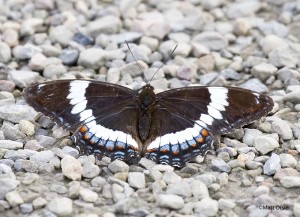Over the fourth of July weekend Barry Marts and I headed out in rain showers on Saturday morning heading towards northern New Jersey in search of a couple of life butterflies that had been reported the previous week by various folks. Rick Borchelt and Tom Stock were gracious to share the location information for Eyed Brown and Hickory Hairstreak, the later which had been seen in the hundreds a number of days before on a butterfly count. We arrived at our first stop in Vernon Township, NJ around 10:15am. There was now a steady rain with few breaks and we waited until 2:15pm when it finally stopped and a few butterflies appeared including our target species Eyed Brown. Eyed Brown looks similar in size and eye spot pattern as the Appalachian Bown and their ranges do overlap. Reliable separation can be done by looking at the ventral forewing post median band which is jagged as compared to the very smooth VPM band on the Appalichian Brown. The ventral hind wing basal line has what I call a “sharks tooth” pattern near the leading edge of the forewing. On the Appalachian Brown it is straight. Finally, the ground color overall on fresh individuals looks orange-brown on the Eyed Brown and gray-brown on the Appalachian Brown. You can compare the Eyed Brown and Appy Brown images below by clicking on them. Next, it was off to Whittingham WMA near Newton, NJ to see if we could find a Hickory Hairstreak. We arrived late, about 4:15pm and it was still cloudy. Everything was wet from the rains so our boots/shoes and lower pants got soaked walking around a couple of the fields. Luck was on our side as we found 9 Hickory Hairstreaks, 3 Banded Hairstreaks and a couple of Hairstreak spuhs unidentifiable due to wear. Superficially Banded and Hickory Hairstreaks can look very similar and an aggregate of ID characteristics should be used to separate the two. There is variation in both species and some can not be ID’ed by sight or photo. As a good rule Hickory will show a significant blue spot extension past the orange spot whereas Banded’s blue spot will for the most part be nearly equal in length with the orange spot. Both sides of Hickory’s forewing post median band are typically edged in white where you don’t see this very much in Banded. In Hickory, the width of the forewing PM band right at the leading edge is as wide or wider than the most basal forewing band where on the Banded the width is usually narrower than the most basal forewing band. Finally, on Hickory there are noticable “spikes” at the very end of the forewing PM band ether pointing up or down or both. I’ve yet to see this trait on a Banded Hairstreak. If you have a photo to the contrary please email me. I’d love to see it. I’ve included side by side images of Hickory and Banded below that you can click on to see a larger image.
After an overnight in Stroudsburg, PA it was off through the fog Sunday morning to Pocono Pines, PA. The fog finally burned off enough by 10:00 and we found 4 species of Hairstreaks, all on Milkweed (Edwards’, Acadian, Banded, Striped). Other notable species here were Blash Dash and fresh Delware Skippers. A terribly worn Hobomok Skipper was still hanging on. It was here that we saw our first of a few hybrid Canadian Tiger Swallowtails X Eastern Tiger Swallowtails (pers comm. with David Wright). They look like miniturized versions of our Appalichian Tiger Swallowtails in the higher WV elevations. David said “PS – What you’re seeing is a “late flight” of a bimodal Papilio canadensis x glaucus hybrid. Yes, it looks very much like small appalachiensis“. In the afternoon we went to Ricketts Glen State Park where we found 26 species including Two-spotted Skipper, Bog Copper, Coral Hairstreaks, Banded Hairstreaks, Great Spangled / Aphrodite / Atlantis Fritillaries and White Admirals. This is very diverse region both in habitat and geology. The Alleghany Front escarpement cuts right through the park and you gain 1,200ft in a mere 3 miles or so going north on Rt 487. Hackberry, Blackberry, Blueberry and Cranberry and I’d bet a couple more berry species are found here. All told 36 species were found on the trip.
7-4 Sussex county, NJ 1 Silver-spotted Skipper 8 Least Skipper 2 Cabbage White 2 Clouded Sulphur 3 Pearl Crescent 3 Red Admiral 23 Eyed Brown 7-4 Whittingham WMA, NJ 2 Little Glassywing 1 Orange Sulphur 11 Hickory Hairstreak 3 Banded Hairstreak 2 Eastern Tailed-Blue 30 Great Spangled Fritillary 1 Eastern Comma 1 Common Wood-Nymph 7-5 Pocono Pines, PA 4 European Skipper 20 Little Glassywing 3 Delaware Skipper 1 Hobomok Skipper 2 Black Dash 14 Dun Skipper 1 Eastern Tiger Swallowtail 2 Cabbage White 2 Clouded Sulphur 1 Acadian Hairstreak 1 Edwards' Hairstreak 2 Banded Hairstreak 1 Striped Hairstreak 1 Eastern Tailed-Blue 1 Summer Azure 10 Great Spangled Fritillary 2 Aphrodite Fritillary 1 Question Mark 1 Common Wood-Nymph 7-5 Ricketts Glen State Park, PA 4 European Skipper 2 Peck's Skipper 27 Long Dash 2 Little Glassywing 1 Delaware Skipper 9 Two-spotted Skipper 4 Dun Skipper 5 Eastern Tiger Swallowtail 2 Cabbage White 7 Clouded Sulphur 3 Orange Sulphur 17 Bog Copper 2 Banded Hairstreak 3 Coral Hairstreak 5 Eastern Tailed-Blue 17 Summer Azure 1 Monarch 23 Great Spangled Fritillary 5 Aphrodite Fritillary 14 Atlantis Fritillary 2 Red-spotted Purple 3 White Admiral 3 Pearl Crescent 1 Baltimore Checkerspot 1 Red Admiral 1 Common Wood-Nymph
Click on any image below to enlarge
 |
 |
 |
 |
 |
 |
 |
 |
 |
 |
 |
 |
 |
 |

Beautiful, stunning images! First-class photography Matt.